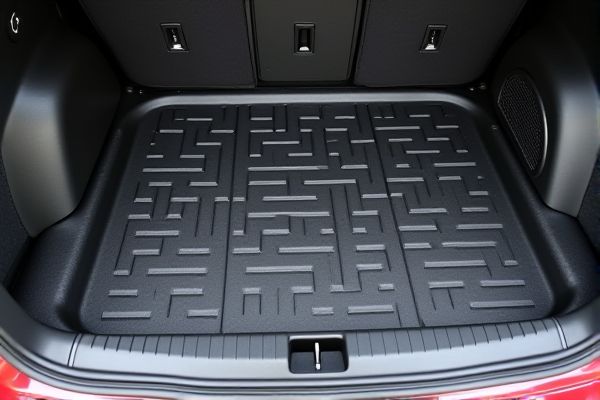
Plastic boot trays offer lightweight, affordable protection with easy cleaning and resistance to rust, while metal boot trays provide superior durability and sturdiness suitable for heavy use but may require more maintenance. Explore the detailed comparison to determine which boot tray best suits Your needs and lifestyle.
Table of Comparison
| Feature | Plastic Boot Tray | Metal Boot Tray |
|---|---|---|
| Material | Durable plastic, lightweight | Sturdy metal, often steel or aluminum |
| Weight | Lightweight, easy to move | Heavier, more stable |
| Durability | Resistant to corrosion and rust | Highly durable but prone to rust if untreated |
| Water Resistance | Waterproof and easy to clean | Water-resistant; requires maintenance to prevent rust |
| Cost | Generally more affordable | Usually more expensive |
| Design | Available in various colors and flexible designs | Typically minimalist and industrial look |
| Environmental Impact | Less eco-friendly due to plastic production | More recyclable and sustainable if maintained |
| Use Case | Ideal for casual, light-duty use | Best for heavy-duty, long-lasting use |
Introduction to Boot Trays: Plastic vs Metal
Plastic boot trays offer lightweight, corrosion-resistant solutions ideal for everyday use and easy cleaning. Metal boot trays provide superior durability and withstand heavy wear, making them suitable for challenging environments and long-term use. Choosing between plastic and metal boot trays depends on factors like weight, durability, and intended usage conditions.
Material Composition and Durability
Plastic boot trays are typically made from high-density polyethylene (HDPE) or polypropylene, offering lightweight and corrosion-resistant properties ideal for protecting floors from water and mud. Metal boot trays, usually constructed from steel or aluminum, provide superior durability and resistance to heavy impacts but may be prone to rust if not properly coated or maintained. The choice between plastic and metal trays depends on the required strength, environmental exposure, and maintenance preferences.
Design and Aesthetic Appeal
Plastic boot trays offer versatile designs with a wide range of colors and textures, making them easily customizable to match your interior decor. Metal boot trays provide a sleek, industrial look with durable finishes like stainless steel or powder coating that resist wear and add a modern aesthetic. Your choice depends on whether you prefer the lightweight, adaptable style of plastic or the robust, polished appearance of metal trays.
Weight and Portability
Plastic boot trays are significantly lighter than metal boot trays, enhancing portability and ease of handling during transport and storage. The reduced weight of plastic trays makes them ideal for frequent movement or use in multiple locations without causing strain. Metal boot trays, while heavier and less portable, offer greater durability but are less convenient for users prioritizing lightweight solutions.
Water and Dirt Containment Efficiency
Plastic boot trays excel in water and dirt containment due to their typically higher edges and non-porous surfaces, preventing spills and making cleanup easier. Metal boot trays offer durable containment but may have seams or holes that allow water to leak if not properly designed or coated. Your choice depends on whether ease of maintenance or long-term durability is more important for your shoe storage needs.
Ease of Cleaning and Maintenance
Plastic boot trays offer superior ease of cleaning due to their smooth, non-porous surfaces that resist dirt and moisture buildup, allowing for quick rinsing and wiping. Metal boot trays, often made from stainless steel or aluminum, provide durability but may require more effort to prevent rust and corrosion, especially if scratched or exposed to water over time. Both materials benefit from regular cleaning, but plastic trays generally demand less maintenance to keep them looking new and functional.
Cost Comparison: Plastic vs Metal Boot Trays
Plastic boot trays generally cost significantly less than metal boot trays, making them a budget-friendly option for many households. Metal boot trays, while more expensive, offer enhanced durability and longevity, often justifying the higher initial investment. The choice between plastic and metal often hinges on balancing upfront costs with long-term wear resistance.
Environmental Impact and Sustainability
Plastic boot trays often have a higher environmental impact due to their reliance on non-renewable petroleum resources and longer decomposition times in landfills, contributing to microplastic pollution. Metal boot trays, usually made from recyclable materials like steel or aluminum, offer enhanced sustainability through their durability and recyclability, reducing the need for frequent replacements and minimizing waste. Choosing metal trays supports circular economy principles by enabling material recovery and reducing environmental footprint compared to conventional plastic alternatives.
Best Use Cases for Each Material
Plastic boot trays are ideal for lightweight, everyday use, offering water resistance and easy cleaning, making them perfect for entryways prone to mud and rain. Metal boot trays provide superior durability and heat resistance, suitable for heavy-duty environments such as workshops or garages where boots may encounter grease, oils, or sharp debris. Choosing between plastic and metal depends on factors like exposure to harsh conditions, weight tolerance, and desired longevity for boot protection.
Final Verdict: Choosing Between Plastic and Metal Boot Trays
Plastic boot trays offer lightweight durability, resistance to rust, and easier cleaning, making them ideal for everyday use in wet or muddy conditions. Metal boot trays provide superior strength and long-lasting protection against heavy impacts or sharp objects, suitable for rugged environments. Your choice depends on whether you prioritize ease of maintenance and corrosion resistance (plastic) or enhanced durability and robustness (metal).
 homyna.com
homyna.com